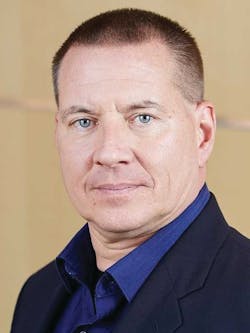Aerospace/defense & RF industry predictions
Download this article in .PDF format.
Several RF and microwave technologies will drive the industry forward throughout 2019
The industry will continue to move toward technologies that have higher levels of integration and flexibility to enable multiple-use subsystems. Reusability drives down cost but, more importantly, accelerates time to market. Manufacturers’ re-use of the same hardware and software, as well as accumulated engineering knowledge across multiple platforms, mitigates risks and allows for rapid reconfiguration.
This year will see significant investments and design supporting massively parallel MIMO designs. Adoption will drive increases in data capacity and coverage in developed nations.
Research and development is top of mind with 5G on the horizon
Before 5G becomes available on a global scale, RF technologies will meet critical checkpoints in performance. Of great importance is the availability of spectrum, whether it be low-, mid-, or high-band. In sub 6GHz, the coverage layer will be built on massive MIMO using existing infrastructure followed by densification. Small cell deployments will be more critical to 5G rollout, taking advantage of the higher frequencies.
As 5G continues to grow in relevance, everyone from component suppliers to service providers will be increasingly forced to manage their costs and respective business models. 5G promises orders of magnitude improvement in data capacity, however it comes at the expense of added equipment complexity and higher costs.
Innovation and breakthrough will continue in aerospace & defense
For aerospace and defense companies, RF and microwave systems will continue to push higher into the spectrum. As threats increase, it becomes important to address both enemy and friendly operations up to 130Ghz.
In addition, current innovation in the architecture of RF and microwave transceivers greatly increases flexibility through software defined features, and vastly improves packaging density to reduce size. These features have significant positive impacts on many defense systems, including smart munitions applications. We will continue to see these innovations develop and be further refined in 2019.
Increased focus on extending battery life for soldier systems will drive down power management requirements for all types of military communication systems. A move toward balanced transceiver cores, along with better power management systems, will be critical in this drive.
Modern high-speed converters and transceivers offer the ability to sample at higher IF frequencies, and due to this, will grow in popularity in the industry. Use of these latest releases can simplify frequency plans, eliminate mixing stages, and reduce companion agile LO complexity.
The super heterodyne approach has been around for over 100 years now and can provide exceptional performance with proper frequency planning. It is also, unfortunately, the most complicated, as it requires the most power, the largest physical footprint relative to available bandwidth, and frequency planning can be quite challenging at large fractional bandwidths. This approach with modern high-speed converters and transceivers will give designers more flexibility and options with their planning.
Another approach, direct sampling, has long been sought after, as a way to operate the converters at speeds commensurate with direct RF-sampling, and achieve large input bandwidth. Today, high-speed converters are available for direct sampling through S-Band and higher. A new trend that has started in 2018 and will proceed into 2019, however, is sampling at GSPS rates with analog input bandwidths above 6GHz. Direct sampling to higher frequencies will continue to be a trend to watch in emerging data converters. As next-generation FinFET CMOS nodes continue to increase the transistor operating speeds and reduce parasitic capacitance, new families of data converters will become possible with the potential to have a significant impact on future RF system design.
SWaP challenges with digital beamforming arrays lead to innovation designs
- As frequency increases to X Band (10GHz), it is challenging but possible with advanced integration
- At Ka Band it is quite challenging
- As frequency increases, hybrid architectures will become more practical and 4:1 beamformers will be able to reduce the receiver/exciter, allowing additional space to be allocated for the RF electronics
The industry will work to integrate full sections of the signal chains. Multichannel integrated transceivers and converters form the foundation for RF sampling in a reduced physical footprint.
In addition, integrated RF design in monolithic RFICs, SiPs (System in Package), and integrated T/R modules will continually advance. The combination of multichannel, high-speed converters or transceivers along with RF advancements enable the integration needed for modern phased array implementations.
Sean D’Arcy joined Analog Devices in 2015 and is part of the Aerospace and Defense marketing team, focusing on aviation, unmanned systems, missiles and munitions. Peter Delos has been a technical lead at Analog Devices since 2016. He worked in the Naval Nuclear Power program from 1990 to 1997, and has nearly 20 years of experience in RF systems designing at the architecture, PWB, and IC levels.




